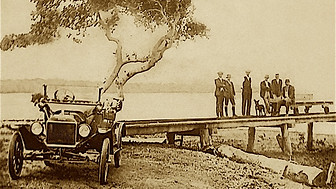DISCOVER HERITAGE & HISTORY
Millennia of Culture, Flinders' Landing, Farming and early Tourism on the island.
KUTCHI-MUDLO
Goochie mudlo
Coochiemudlo is Quandamooka Country.
The three clans of the Quandamooka People (Nughi, Nunukul and Goenpul) are the traditional custodians of the sizeable coastal area that stretches from the mouth of the Brisbane River in the north, throughout the islands of Central and Southern Moreton Bay, south as far as the Logan River.
Quandamooka means ‘the area of Moreton Bay’.
There is archaeological evidence of at least 25,000 years of Aboriginal occupation on nearby Stradbroke Island. On Coochiemudlo Island, where resources like fresh water were limited by its small size, traces of Aboriginal presence have been found in the form of shell middens, stone mortars and scarred trees.
The spiritual significance of the rich red ochre, visible from the mainland on the island's southern flank, is reflected in the name chosen by the Quandamooka People of the Jandai language group. ‘Goochie mudlo’ for 'red earth' and 'rock' or 'stone' (also recorded as ‘kutchi mudlo’) became ‘Coochiemudlo’ as it is known today. Coochiemudlo is an island mentioned in Quandamooka Dreaming stories.

Yura, bunji !
"Welcome/Hello Friend !"
in the Jandai language spoken
by the Quandamooka People
Celebrating country, culture and people

Since 2015, the Quandamooka People celebrate country, culture and people of the region in a three-month festival of events, exhibitions, music, talks and walks all over the Redlands.
The Quandamooka Festival is a great occasion for locals and visitors to join the celebration and learn more about the traditional owners of this beautiful and unique region, every year from June to August. More info :
For more information about Indigenous history and heritage in the Redlands start on the Redland City Council website
and contact the Quandamooka Yoolooburrabee Aboriginal Corporation (QYAC) who have kindly assisted with this part of the website.
Young Quandamooka Dancers at the 2016 festival. (Photo : QYAC)
FLINDERS' LANDING
In 1799, Flinders undertook another voyage onboard the Norfolk, north of Sydney in search of major navigable rivers.
On July 19, he stepped ashore Coochiemudlo Island.


English navigator and cartographer Matthew Flinders (1774-1814) is remembered for proposing the name Australia for the country he was the first recorded European to circumnavigate during 1802 and 1803. His voyage around the coast of Tasmania proved it and the mainland were indeed islands, not a continent.
After joining the Royal Navy at the age of 15, Flinders trained as a navigator. His charts proved so accurate they were used for many years after his death.
In 1796, he explored the coastline south of Sydney in a tiny boat called Tom Thumb with his colleague and friend, naval surgeon George Bass (1771-1803). Both men embarked in 1798 on the sloop Norfolk and sailed around what was still called Van Diemen’s Land, mapping the coast of Tasmania. Bass Strait - the passage between Australia and Tasmania - was named after George Bass.

Every year, the arrival of this great explorer is celebrated on the island with a re-enactment of his landing by dedicated locals. Flinders Day and Coochie markets take place every year on the Sunday closest to July 19, with navy cadets and pirates joining in the celebrations. Visitors might spot Trim, Matthew Flinders' beloved cat who accompanied him for many years on his sea travels.
FLINDERS' Day !
Blog post :

Five Things to know about Flinders' Day on Coochiemudlo

FARMERS, SETTLERS AND SEA-CHANGERS
It took until 1842 for Coochiemudlo Island to be opened for free settlement, along with the rest of the Moreton Bay region. Temporarily, the island was known as Innis Island, but soon reverted to its Aboriginal name in the Quandamooka language, with the anglicised spelling ‘Coochiemudlo’.
The state of Queensland was formed in 1859 and the first industries on the island reflected the activities of the region now known as the Redlands: logging, oyster farming, and fruit and vegetable production for the growing needs of the port and river city of Brisbane. Later, cattle were mustered across the channel from Victoria Point for grazing on Coochie.

In the 1920s, Mary Morton was the first woman to live on Coochiemudlo Island, with her war veteran husband Doug. The couple are remembered as fine farmers and for recognising the interest of developing tourism from Brisbane. Doug Morton built jetties and provided transport on the island, while Mary served Devonshire Tea and refreshments at their farm.
Mary and Doug Morton with
their dog Bonnie.

Doug Morton's jetty in Victoria Point. Photos from Cleveland Library,
Local History Collection, courtesy of Joan Bland.
In the late 1950s, large sections of the island were sold in small subdivisions suitable for holiday cottages. By 1970, there were still only about 20 permanent residents on Coochie.
The introduction of town water, a regular ferry service, electricity, a car barge, sewerage and the internet between the 1970s and the present have led to a gradual increase of the island population, which was around 750 in nearly 600 dwellings at the 2016 Census.

Today, Coochiemudlo is home to a mix of permanent residents and holiday visitors, with a population of commuters, families, retirees, tradespeople, artists and tourism service providers.
